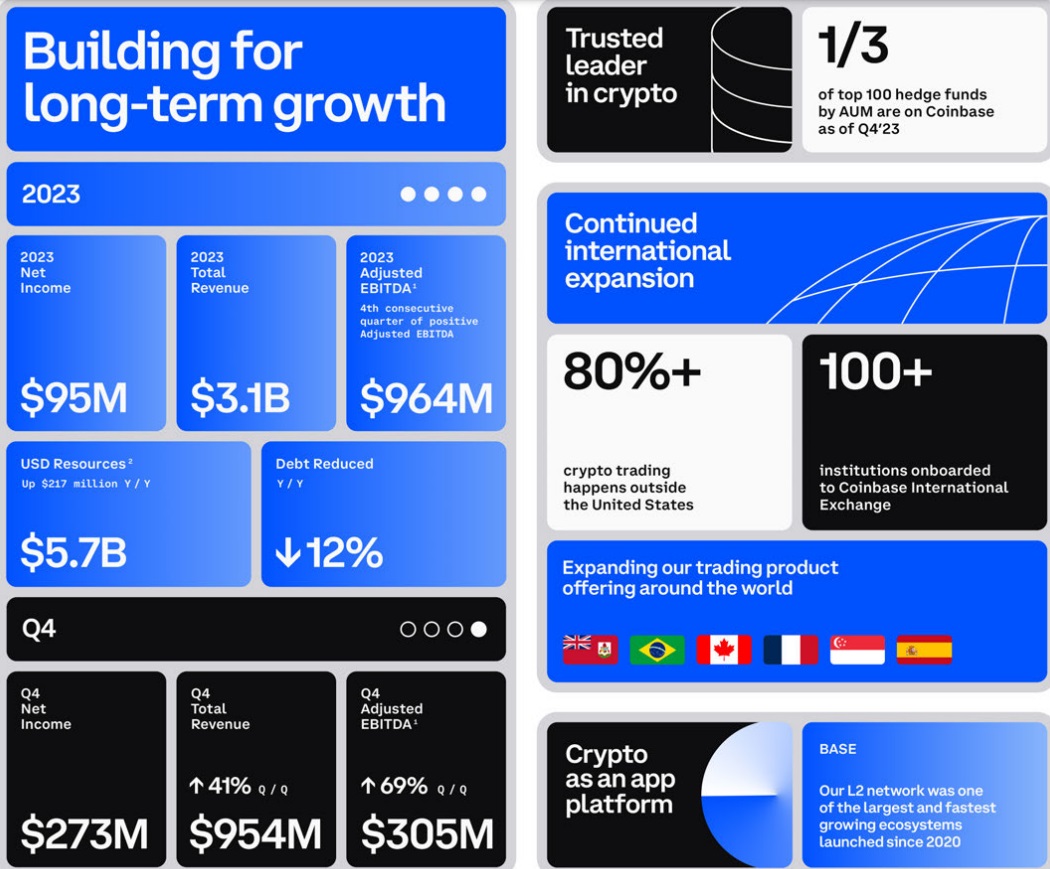Coinbase Has $420B in Assets Under Management, Surpassing the 21st Largest US Bank
Key Takeaways:
- With an AUM of $420 billion, Coinbase is one of the most significant players in the financial market.
- CEO Brian Armstrong envisions a future where crypto platforms streamline traditional financial services.
- Although it has expanded, issues with user safety and transaction complexity remain major barriers to the widespread adoption of crypto.
Seismic Shift of Coinbase: The Redefinition of Finance with $420 Billion in Assets Under Management
The financial world is undergoing a major transformation, with Coinbase emerging as a prime example. Initially a cryptocurrency exchange, it is now evolving into a financial powerhouse. With an impressive $420 billion in assets under management (AUM), Coinbase is more than just a place where you can trade virtual currency; it is a driving force to the entire financial sector along the way. CEO Brian Armstrong stated that Coinbase operates like a bank in the U.S., and this is indeed true as the company introduces radical changes, making financial systems more accessible and interactive.
The Numbers Revealed: The AUM Figures of Coinbase in a Nutshell
Armstrong’s analogy of Coinbase to a traditional bank is based on its massive AUM. He clarified that, in this context, Coinbase would rank as the 21st largest bank in the United States. As a brokerage, it would be successful based on AUM and be the 8th biggest.
According to Armstrong, the comparison of Coinbase to a traditional bank depends on its huge AUM. He stressed that, on the strength of this particular measure, Coinbase would be rated as the 21st biggest bank in the USA. As a broker, it would be the 8th largest based on AUM.
If you think of Coinbase like a bank, we now hold about $0.42T in assets for our customers, which would make us 21st largest bank in the US by total assets, and growing.
If you think of us more like a brokerage, we’d be the 8th largest brokerage today by AUM.
If you think of us…
— Brian Armstrong (@brian_armstrong) February 7, 2025
To put this into perspective, we can compare Coinbase’s AUM with that of New York Community Bancorp (NYCB), the actual 21st largest bank in the US. NYCB controls about $112.9 billion in assets, which is nowhere near Coinbase’s holdings. Thus, the very uneven distribution shows that the cryptocurrency market’s unbelievable growth has been the driving force and that virtual money complementing traditional financing has been a notable game-changer in the broader financial sector.
Coinbase’s AUM is not just a figure to boast about; it represents significant financial influence. With such a considerable financial resource, Coinbase has the chance to go into the development and spreading of various complex technologies and services related to digital money.
The “Neobank” Revolution: Consolidating Financial Services
It should be noted that Armstrong’s dream does not stop at collecting assets just for the sake of it. He foresees the future of cryptocurrency platforms acting as “neobanks,” which will be able to make all the main financial services available under one smooth and user-friendly interface. He believes that the traditional separation of banking, investing, and payments is outdated and inefficient.
Can you picture a situation where you easily monitor your checking account, investment settings, cryptocurrency, and also take out loans, from a single location? This is the neobank revolution, and Armstrong is confident that crypto will be the tool to make it happen.
Empowerment isn’t just about convenience, it’s about the vision. By streamlining financial services, neobanks can enhance access to financial services for underprivileged populations, fostering greater financial inclusion and economic opportunity.
Financial technology companies can simplify access to financial services, breaking down barriers that have traditionally excluded many from markets. Paying for transactions through neobanks has increased at a higher rate of adoption and usage among people and firms, especially among the unbanked. Financial illiteracy and exclusive financial services created barriers that operators of neobanks are breaking through. This, in turn, is increasing the rate of financial inclusion, which in itself is fostering a stable financial system and boosting people’s economics.
To illustrate the idea of neobanking, let’s take the example of a freelancer. Usually, freelancers are forced to handle invoices, list expenses, settle taxes, and perhaps even use the money to buy things in various apps. Through a neobank that is fueled by cryptocurrencies, all these processes could be potentially automated. Payments may be made directly in cryptocurrency or exchanged into fiat automatically. A smart contract could be set up to be able to automatically add expenses on students’ and teachers’ accounts and the tax obligations could be calculated and set aside automatically. Moreover, their earnings could be directly invested in dozens of crypto or traditional assets, all through the same interface.
Rapid Update Background and Definition of Stablecoins
Stablecoin transactions for $30 trillion done last year are the first sign of the future evolution of payments which is very tempting to people. This highlights the power of stablecoins, which combine the speed and efficiency of digital currencies with the stability of fiat currencies.
They are considered a unique option for numerous uses, such as daily purchases, money transfers between countries. Just imagine yourself sending your friend/family member money in just a few seconds with no fees and no changing rates. This is the benefit of stablecoin-based payments.
Yet, the industry must first be transparent and comply with the regulations in order to gain more trust and to expand its usage.
Addressing the Elephant in the Room: Security, Friction, and Regulation
On one hand, the ongoing development of Coinbase and the whole crypto market is beyond doubt, yet one cannot ignore the fact that there are huge problems still to be solved. These are challenges, which include:
- Security Concerns: Security breaches and hacks in the crypto space have resulted in significant financial losses for users. Robust security infrastructure is essential to safeguard funds and maintain trust in the network.
- User Friction: Getting a crypto wallet, managing seed phrases, and otherwise struggling through complicated, lengthy transactions may be a cumbersome task for new users. Making the user interface simple is the most important thing to do to experience a wider audience.
- Regulatory Uncertainty: The evident lack of clear and consistent regulations in many different places causes disagreements and slows the progress of the tech. In this regard, establishing a dependable legal foundation is crucial to a peaceful and prosperous crypto market.
Coinbase, along with other industry leaders, is actively working to address these challenges, but collective effort is required. The entire crypto community should prioritize security, user experience, and regulatory compliance to create a more mature and reliable ecosystem.
Coinbase’s Profitability: A Sign of Maturation
Coinbase’s profitability in the last few months is a compelling aesthetic, due to the fact that it has found a business model that is effective in the long run. Coinbase reported a $273 million net profit, in contrast to NYCB’s $260 million loss in the same period, highlighting the shift towards crypto-centric business models. The cryptomarket is expected to mature and acceptance numbers will increase, as a result of which Coinbase is going to take full advantage of the growth.
However, maintaining profitability will require Coinbase to continue innovating, expand its product offerings, and manage costs effectively. It is a matter of fact that the company has to confront and comply with the regulation of the ever-changing growth of the industry and the preference of the consumers.

Coinbase Q4, 2024, earnings results. Source: Coinbase
Beyond the Hype: The Real-World Impact of Crypto Finance
The potential of cryptocurrency and blockchain technology to revolutionize finance goes beyond being the next big thing on Wall Street and in Silicon Valley. Imagine a farmer in a developing country who can access microloans through a decentralized lending platform, bypassing traditional banks and their high interest rates. Or think about a small business owner who can accept payments in cryptocurrency from clients worldwide without paying the heavy transaction costs. These are just a few examples of how crypto finance can empower individuals and businesses, fostering greater economic inclusion and opportunity.
But this is not to say that doing so will be easy or simple. High-profile fraud, rug pulls, and flash-in-the-pan crypto schemes must be avoided as the industry and its governance become more established.
More News: Coinbase Asks a Court to Declare Crypto Not a Security: A Landmark Legal Battle with the SEC
The Future of Finance: A Crypto-Powered World?
Coinbase’s rapid expansion and Armstrong’s vision suggest that we are on the brink of a future where crypto serves as the new financial system. While the initial hurdles are still on the horizon, there is no denying that a financial world supported by crypto carries untold advantages. Following the technological advance and the rise of the adoption, we are bound to witness even more innovative and disruptive technologies in the coming years.
Moving forward, collaboration between industry leaders, regulators, and the broader community will be crucial to building a secure and sustainable crypto ecosystem. Whether or not Coinbase becomes the next JP Morgan Chase, its impact on the future of finance is undeniable.
The post Coinbase Has $420B in Assets Under Management, Surpassing the 21st Largest US Bank appeared first on CryptoNinjas.
CryptoNinjas




















